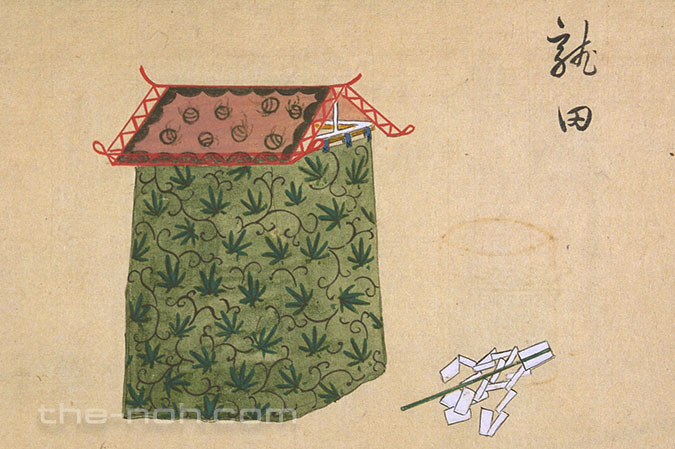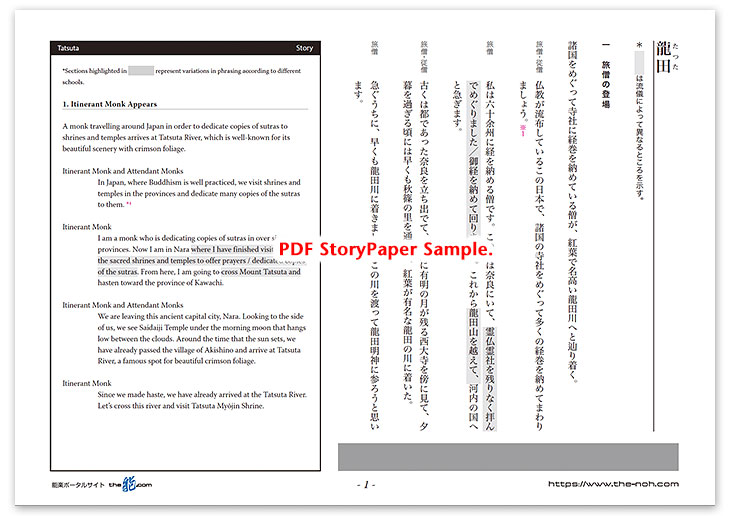
 Tatsuta
Tatsuta

![]()
An itinerant monk is traveling to shrines and temples all over Japan in order to dedicate copies of Buddhist sutras. One winter, he comes to visit temples in Nara and arrives at the Tatsuta River, well-known for its beautiful views with crimson foliage. When he is about to cross the river to go to Tatsuta Myōjin Shrine, a woman appears and recites ancient poems as a warning to the monk not to cross the river. She identifies herself as a shrine maiden of Tatsuta Myōjin Shrine and guides him to a different route to get to the shrine. At the shrine, the monk finds a maple tree full of crimson foliage, although it is midwinter. When the monk asks the shrine maiden about the mysterious tree, she replies that it is a sacred tree of this shrine. While they are visiting halls in the precinct of Tatsuta Shrine, the shrine maiden reveals that she is the goddess Tatsuta and then vanishes into the shrine altar.
A villager who has stopped by Tatsuta Myōjin Shrine tells the monk the story of Tatsuta Myōjin and the crimson foliage, implying that the woman the monk met must be a manifestation of the goddess Tatsuta. He goes on to suggest that the monk stay and witness an extraordinary event. At night, when the monk is performing sutra recitation, the goddess Tatsuta appears from a hall of the shrine. She narrates the history of Tatsuta Myōjin Shrine, recites ancient poems about the beauty and sanctity of Tatsuta and once again asks the monk not to cross the river. The goddess Tatsuta waves a Shinto hei wand decorated with white cloth while performing a dance and then gracefully dances her way upward, ascending to the heavens as dawn breaks.
![]()
The poems introduced in the first half of the play—one anthologized in Kokin Waka-shū (Collection of Japanese Poems of Ancient and Modern Times) and another composed by Fujiwara no Ietaka—laud the beauty of the crimson foliage that is also an object of veneration at Tatsuta Myōjin Shrine. Many poems are also cited in the second half, while the kuse section describes the beautiful scenery and crimson foliage in Tatsuta that provide the visual and musical climax of this play. The spectacular kagura dance performed by the lead character in the second half is said to preserve an ancient style of kagura, which is performed with music played in a dignified tone.
This play uses a stage prop, an ichijō-dai platform with a small shrine placed on top of it. The lead character uses this prop effectively—she enters the shrine at the interlude and in the second half of the play, reemerges from it as the gorgeous goddess Tatsuta.
Unlike other plays such as Miwa and Kazuraki, in which a woman is transformed into a goddess and then performs a kagura dance, this piece avoids depictions of human suffering and focuses solely on the sophisticated elegance of the goddess.
STORY PAPER : Tatsuta
Story Paper presents noh chant stories in modern speech, with story outlines, highlights and more using Adobe PDF format, which can print out and zoom in. Print out the pages and take them with you when you see the actual noh performance.

The copyright of Story Paper is held by the Noh.com. Story Paper is for individual use only. It is prohibited by the copyright law to distribute or publish printed-out Story Paper pages without prior consent. For more information, check the credit and disclaimer pages.



 [Tatsuta : Story Paper PDF : 495KB
[Tatsuta : Story Paper PDF : 495KB